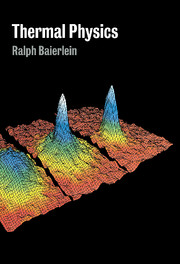Book contents
- Frontmatter
- Contents
- Preface
- 1 Background
- 2 The Second Law of Thermodynamics
- 3 Entropy and Efficiency
- 4 Entropy in Quantum Theory
- 5 The Canonical Probability Distribution
- 6 Photons and Phonons
- 7 The Chemical Potential
- 8 The Quantum Ideal Gas
- 9 Fermions and Bosons at Low Temperature
- 10 The Free Energies
- 11 Chemical Equilibrium
- 12 Phase Equilibrium
- 13 The Classical Limit
- 14 Approaching Zero
- 15 Transport Processes
- 16 Critical Phenomena
- Epilogue
- Appendix A Physical and Mathematical Data
- Appendix B Examples of Estimating Occupation Numbers
- Appendix C The Framework of Probability Theory
- Appendix D Qualitative Perspectives on the van der Waals Equation
- Index
12 - Phase Equilibrium
Published online by Cambridge University Press: 05 June 2012
- Frontmatter
- Contents
- Preface
- 1 Background
- 2 The Second Law of Thermodynamics
- 3 Entropy and Efficiency
- 4 Entropy in Quantum Theory
- 5 The Canonical Probability Distribution
- 6 Photons and Phonons
- 7 The Chemical Potential
- 8 The Quantum Ideal Gas
- 9 Fermions and Bosons at Low Temperature
- 10 The Free Energies
- 11 Chemical Equilibrium
- 12 Phase Equilibrium
- 13 The Classical Limit
- 14 Approaching Zero
- 15 Transport Processes
- 16 Critical Phenomena
- Epilogue
- Appendix A Physical and Mathematical Data
- Appendix B Examples of Estimating Occupation Numbers
- Appendix C The Framework of Probability Theory
- Appendix D Qualitative Perspectives on the van der Waals Equation
- Index
Summary
In a loose sense, this chapter is about the coexistence of solids, liquids, and gases, usually taken two at a time. What physical condition must be met if coexistence is to occur? What other relations follow? The chapter provides some answers. And in its last section, it develops a classic equation—the van der Waals equation of state—that was the first to describe gas and liquid in coexistence.
Phase diagram
Figure 12.1 displays three phases of water as a function of pressure and temperature. By the word phase, one means here a system or portion of a system that is spatially homogenous and has a definite boundary. [In turn, homogeneity means that the chemical composition (including relative amounts), the crystalline structure (if any), and the mass density are uniform in space. A continuous variation produced by gravity, however, is allowed, as in the case of a finite column of air in the Earth's gravitational field.] The liquid phase is typified by a glass of water; the solid, by an ice cube; and the vapor, by the “dry” steam (that is, steam without water droplets) in the turbine of a power plant, as was illustrated in figure 3.1.
Of more interest, however, are the curves in the drawing, locations where two phases coexist. When a pond freezes over and develops a 20 centimeter layer of ice, the lower surface of the ice and the top of the remaining liquid water coexist at a temperature and pressure that lie along the leftward (and upward) tilted curve that emanates from the triple point.
- Type
- Chapter
- Information
- Thermal Physics , pp. 270 - 305Publisher: Cambridge University PressPrint publication year: 1999
- 1
- Cited by



